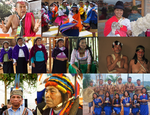Portal:Ecuador/Selected biography
| This page is currently inactive and is retained for historical reference. Either the page is no longer relevant or consensus on its purpose has become unclear. To revive discussion, seek broader input via a forum such as the village pump. |
Indigenous peoples in Ecuador are the groups of people who were present in what became the South American nation of Ecuador when Europeans arrived. The term also includes their descendants from the time of the Spanish conquest to the present. Their history, which encompasses the last 11,000 years, reaches into the present; 25 percent of Ecuador's population is of indigenous heritage, while another 65 percent is of mixed indigenous and European heritage. Black people, people of Spanish descent, and others make up the remaining 10 percent.
While archaeologists have proposed different temporal models at different times, the schematic currently in use divides prehistoric Ecuador into five major time periods: Lithic, Archaic, Formative, Regional Development, and Integration. These time periods are determined by the cultural development of groups being studied, and are not directly linked to specific dates, e.g. through carbon dating.
The Lithic period encompasses the earliest stages of development, beginning with the culture that migrated into the American continents and continuing until the Late Pleistocene or Early Holocene. The people of this culture are known as Paleo-Indians, and the end of their era is marked by the extinction of the megafauna they hunted.
The Archaic period is defined as "the stage of migratory hunting and gathering cultures continuing into the environmental conditions approximating those of the present."[1] During this period, hunters began to subsist on a wider variety of smaller game and increased their gathering activities.[2] They also began domesticating plants such as maize and squash, probably at "dooryard gardens."[2] In the Andean highlands, this period lasted from 3500-7000 BP.
- ^ Willey, Gordon R.; Philip Phillips (2001) [1958]. R. Lee Lyman (ed.). Method and theory in American archaeology. Classics in Southeastern Archaeology. Michael J. O'Brien (2nd ed.). Tuscaloosa: University of Alabama Press. pp. 104–139. ISBN 0-8173-1088-6.
- ^ a b Marcos, Jorge G. (2003). "A Reassessment of the Ecuadorian Formative". In J. Scott Raymond (ed.). Archaeology of Formative Ecuador (PDF). Richard L. Burger. Washington, D.C.: Dumbarton Oaks, Trustees for Harvard University. p. 13. ISBN 0-88402-292-7.
The initial cultivation of corn probably took place around 6000 B.C.1 on the Santa Elena peninsula and at around 4300 B.C.2 at Lake Ayauchi in the southeastern Oriente of Ecuador (Pearsall 1995: 127–128; Piperno 1988: 203–224, 1990, 1995).

